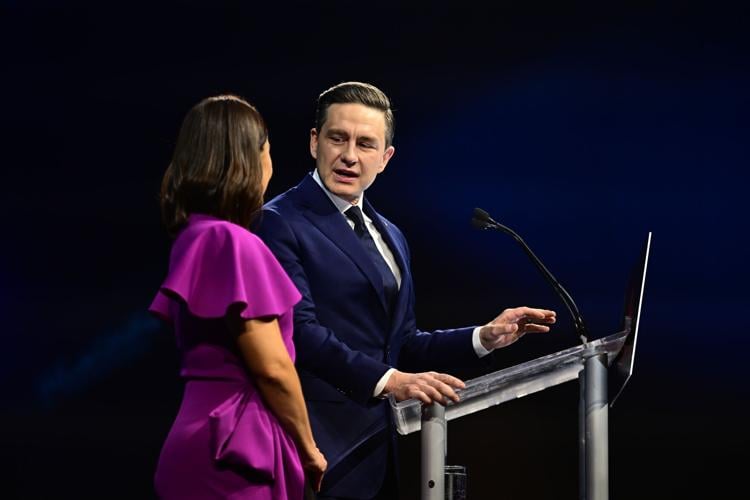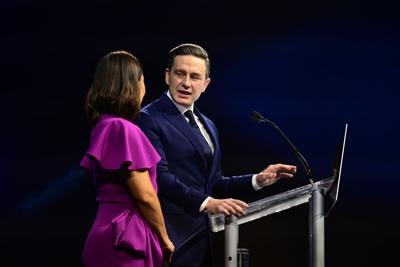įŅį’į’ī°į¬ī°‚ÄĒFī«įý Conservative Leader Pierre Poilievre, Canada‚Äôs 45th election was meant to deliver change.
It did, by heralding a new era for a now road-tested Mark Carney, whose Liberal party was on track toward forming a minority government by late Monday night.
That victory has cemented Poilievre’s legacy as the third Conservative leader to fail to topple the Grits since Justin Trudeau’s Liberals first came to power in 2015.
He was the one to bring the Conservative party to its largest pre-campaign lead in recent memory¬†‚ÄĒ and watched it evaporate as Carney supplanted the unpopular Trudeau amid U.S. President Donald Trump‚Äôs expansionist and protectionist threats.
Yet the Conservative leader suggested in his speech to party faithful that he wasn’t immediately going anywhere, even as his own fate in his Ottawa-area riding of Carleton remained undetermined by the early hours of Tuesday morning.
“It will be an honour to continue to fight for you,” Poilievre said, before he was drowned out by cheers from the crowd.
“We have much to celebrate tonight. We’ve gained well over 20 seats. We got the highest share of votes our party has received since 1988,” the Conservative leader said.
And in a rare show of humility, he admitted there are lessons his party must learn from this campaign if it wants to improve its result the next time Canadians head to the polls.
“We know that change is needed, but change is hard to come by. It takes time, it takes work,” Poilievre said.
Entering election day virtually neck and neck with the Liberals, the Conservatives¬†made some key gains¬†‚ÄĒ and weathered some losses¬†‚ÄĒ as the clock rolled over into Tuesday.¬†
The Tories wrested seats like Aurora‚ÄĒOak Ridges‚ÄĒRichmond Hill and Markham-Unionville away from the Liberals, and did the same in NDP strongholds like¬†Kapuskasing‚ÄĒTimmins‚ÄĒMushkegowuk and Windsor West.
But they also posted tough losses in Peterborough and South Shore‚ÄĒSt. Margarets, losing incumbents Michelle Ferreri and Rick Perkins.
Poilievre’s own seat was challenged by the Liberals’ Bruce Fanjoy, who was leading in a majority of polls.¬†The riding drew the largest advance voting turnout of Canada‚Äôs 343 ridings, but also fell victim to an electoral reform protest movement that saw 91 names on the riding‚Äôs ballot, gumming up the count. In the final week of the campaign, party staff funnelled extra resources into the riding, over fears the leader winning back his seat was no longer guaranteed.¬†
A Conservative source closely involved with the campaign, speaking to the Star on a background basis, confessed the result was not what the party had hoped for, but said Poilievre had built one of the strongest coalitions of support the party had ever seen, including making inroads with blue-collar workers and young Canadians.
The source also mentioned Poilievre’s gains in Ontario, noting that the federal Conservatives’ share of the vote in that province may exceed the vote share held by Premier Doug Ford during the recent Ontario campaign. Ford, and those central to his re-election efforts, had been critical of Poilievre during the federal campaign.¬†
Inside a downtown Ottawa convention centre where supporters congregated, the mood fluctuated between elation and gloom as the results trickled in. By the time Poilievre left the stage, some attendees cried while others embraced one another, capping off a long night where many hoped Poilievre would make history by ending a so-called ‚Äúlost‚ÄĚ decade of Liberal rule.
Nevertheless, the several hundred supporters gathered marked a far cry from the thousands of sign-bearing and merchandise-clad supporters who flocked to Poilievre’s rallies across the country.
It was those rallies his team pointed to when Poilievre fended off criticisms about his party‚Äôs polling slump and whether his decision to fixate on threats within Canada‚Äôs borders¬†‚ÄĒ rather than outside them¬†‚ÄĒ was resonating.
The first week of the race saw the Conservatives grappling with reports of internal disarray and discontent, including concerns that Poilievre’s innermost circle was dismissing calls to refocus their campaign on Trump and move away from relentless sloganeering, like the preoccupation with the consumer carbon price Carney had already abandoned.
The Conservatives’ response was denial, arguing that Poilievre had long been seized with protecting Canada from outside harm.
In some ways, he had; before Poilievre launched his ‚Äúchange‚ÄĚ and ‚ÄúCanada First‚ÄĚ themes of this campaign, he rallied supporters for two years with a message to ‚Äúbring it home.‚ÄĚ
That morphed into campaign promises like accelerating approvals for resource projects, a capital gains tax deferral aimed at reinvesting in Canadian businesses, and a pledge to drop the rate on the lowest income tax bracket from 15 per cent to 12.75 per cent.
But Poilievre never deviated from the domestic issues he insisted should define the contest: crime crackdowns and criminal justice reforms, gutting foreign aid, defunding the CBC and cutting government bloat.
In announcing those policies, the Conservative leader embarked on a cross-country tour that saw him make multiple swings through key battlegrounds in the GTA, B.C.’s lower mainland and Atlantic Canada, while seeking to defend Conservative territory in cities like Calgary and Saskatoon and capture new ground in southwestern and northern Ontario.
His final campaign stop on Sunday night was at a farm in his home riding of Carleton.
‚ÄúI want you to know that no matter what happens tomorrow, I will be there to fight for you, for your quality of life, for your future, for your hopes and aspirations, to bring home the Canadian promise that this country made and kept to my wife, Ana, and I,‚ÄĚ Poilievre told an enraptured crowd.
‚ÄúWe both come from very humble beginnings. It is only in this country that we could be standing in this place.‚ÄĚ
Error! Sorry, there was an error processing your request.
There was a problem with the recaptcha. Please try again.
You may unsubscribe at any time. By signing up, you agree to our and . This site is protected by reCAPTCHA and the Google and apply.
Want more of the latest from us? Sign up for more at our newsletter page.

































To join the conversation set a first and last name in your user profile.
Sign in or register for free to join the Conversation